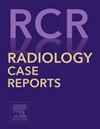右主动脉弓伴有左锁骨下动脉异常和威利斯环供血异常
Q4 Medicine
引用次数: 0
摘要
右主动脉弓(RAA)异常是一种罕见的先天性血管畸形,在普通人群中的患病率为0.01%至0.1%。这些异常通常与先天性心脏异常有关,尽管许多个体仍然无症状并偶然诊断。然而,与RAA相关的脑血管异常先前未见报道。我们报告一例23岁男性偶然发现II型RAA变异,其特征是左锁骨下动脉异常和威氏圈(CoW)异常复杂的结构。CoW异常包括右侧颈内动脉缺失,左侧椎动脉缺失和独特的侧支通路。尽管解剖结构不同,但患者仍无神经症状。在进一步的染色体分析中,没有发现潜在的遗传异常。本病例强调了RAA与CoW异常之间的新联系,强调了RAA患者详细脑血管成像的重要性。由于异常的CoW固有地与脑血管意外风险增加和预后较差相关,因此脑血管解剖信息可以促进主动危险因素监测,并且在需要时对手术/神经介入计划有价值。本文章由计算机程序翻译,如有差异,请以英文原文为准。
Right aortic arch with aberrant left subclavian artery and anomalous Circle of Willis supply
Right aortic arch (RAA) anomalies are rare congenital vascular malformations with a prevalence of 0.01% to 0.1% in the general population. These anomalies are often associated with congenital cardiac abnormalities, though many individuals remain asymptomatic and are diagnosed incidentally. However, cerebrovascular anomalies associated with RAA have not been previously reported. We present the case of a 23-year-old male with an incidental finding of a Type II RAA variant characterized by an aberrant left subclavian artery and an unusual, complex configuration of the Circle of Willis (CoW). This CoW anomaly includes an absent right internal carotid artery, an absent left vertebral artery, and unique collateralization pathways. Despite the variant anatomy, the patient has remained neurologically asymptomatic. No underlying genetic abnormalities were detected during further investigation with a chromosomal analysis. This case highlights the novel association between RAA and anomalies of the CoW, emphasizing the importance of detailed cerebrovascular imaging in patients with RAA. Since an anomalous CoW is inherently associated with an increased risk of cerebrovascular accidents and poorer outcomes, information on cerebrovascular anatomy can facilitate proactive risk factor monitoring, and is valuable for surgical/neuro-interventional planning when indicated.
求助全文
通过发布文献求助,成功后即可免费获取论文全文。
去求助
来源期刊

Radiology Case Reports
Medicine-Radiology, Nuclear Medicine and Imaging
CiteScore
1.10
自引率
0.00%
发文量
1074
审稿时长
30 days
期刊介绍:
The content of this journal is exclusively case reports that feature diagnostic imaging. Categories in which case reports can be placed include the musculoskeletal system, spine, central nervous system, head and neck, cardiovascular, chest, gastrointestinal, genitourinary, multisystem, pediatric, emergency, women''s imaging, oncologic, normal variants, medical devices, foreign bodies, interventional radiology, nuclear medicine, molecular imaging, ultrasonography, imaging artifacts, forensic, anthropological, and medical-legal. Articles must be well-documented and include a review of the appropriate literature.
 求助内容:
求助内容: 应助结果提醒方式:
应助结果提醒方式:


